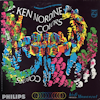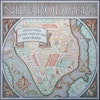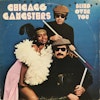Turn on the radio one evening in 1966 and you might have heard Ken Nordine’s smoky baritone invite you to “stare with your ears.” This was no exercise in collective synesthesia, but one of ten ninety-second radio ads for the Fuller Paint Company, each elaborating on the characteristics of a different shade of emulsion.
A spoken-word poet and voice-over artist, Nordine was in his element, combining pithy word play, improvisation, and a meticulous structure to breathe life into each hue. Such was the success of the campaign, Nordine went on to record a full spectrum of thirty-four tracks on his own terms, accompanied by the sparse, after-hours instrumentation of Dick Campbell. Subsequently released by Philips, Colors: A Sensual Listening Experience was sophisticated, surreal, and tinted with social commentary.
By no means his first foray into the recording industry, Nordine had cut his teeth on Chicago’s live poetry circuit, twinning his mellifluous, acerbic verse with the hard-bop jazz licks of the Fred Katz Group (by and large also Chico Hamilton’s band) to create what he dubbed word jazz. The 1957 album was a huge success and landed Nordine a TV appearance with Fred Astaire. He went on to work with gravel-toned protégé Tom Waits, Jerry Garcia, and DJ Food. Unsurprisingly, he was also once cast as the voice of God in a play by Laurie Anderson.
Nordine wrote poetry to the discipline of musical time signatures, and was just as comfortable riffing in 6/5 as the musicians around him. “I like jazz for the principle of what jazz is: a flight of musical fantasy within structure,” he once said. “I’m trying to do the same thing verbally: take off on a theme so you become tangential and transcendent at the same time.”
Colors was both at once, without letting on. No matter how heated the subject became, Nordine’s voice never breached the upper registers of cool. Scratch away a little, however, and his palette could be transgressive, whether in the greedy critique of “Gold,” the veiled takedown of “Beige” suburbia, or the fashion industry’s turncoat optimism in “Olive.”
In fact, look close enough and Colors begins to refract in all sorts of directions—a diabolical mash-up between the worlds of Don Draper, Allen Ginsburg, and Timothy Leary, part prototypical study in mass-media marketing, part artifact of beat generation psychedelic counter-culture. After the original campaign ended, radio listeners are said to have requested reruns of the poems, unaware that they were adverts. Blurring the line between art and artifice, Andy Warhol would have approved.
However, Nordine reserved his most outspoken commentary for “Flesh,” where he decried “color-centric” thinking, asserting that “the proper color of flesh to be is the color it is”—a pertinent call for racial equality and tolerance amid escalating social tensions, two years after the Civil Rights Act banned discrimination based on “race, color, religion, sex or national origin.”
Rather than conform to type, in Nordine’s hands, each shade peels itself off the wall and starts exploring the edges of its own personality. Some live up to their associations, others transcend or subvert them. Together they coexist on this curious, charming record as a dysfunctional, technicolor community (jealousies, rivalries, and lover’s tiffs abound). At one point, Nordine calls his verse “doggerel’s logic,” like the wry aside of a Shakespearean fool—always the wisest of the cast and the only one who sees society for what it is. Of course, this was never just poetry to sell paint.


